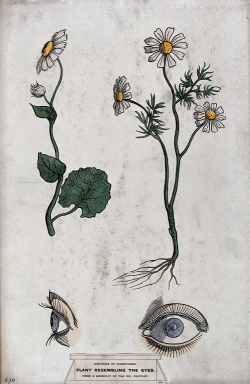
Science Museum
The doctrine of signatures, originally advocated by the Roman naturalist and natural philosopher Pliny, is the observation that the form of a medicinal plant in some way resembles the organ or disease it can be used to treat, an idea that became common during the medieval period.[1] The Swiss physician and alchemist Paracelsus (1493–1541) advocated strongly for the notion, writing that “Nature marks each growth … according to its curative benefit”; the term doctrine of signatures comes from Jakob Böhme’s 1621 book The Signature of All Things. A theological rationalisation was provided by botanists such as William Coles (1626–1662), who believed that God would have wanted to show men what plants would be useful for.[2]
Belief in the doctrine of signatures was very widespread, not only in classical antiquity or medieval Europe: “All American tribes entertain a profound belief in the doctrine of signatures”.[3]
Scientific foundation
The doctrine of signatures is often dismissed as primitive superstition or pseudoscience, but ethnobiologist Badley C. Bennett argues that the theory has been much maligned by modern scholars, who have attempted to provide untestable post hoc explanations for why any given plant is used to treat certain conditions. There is no evidence that an analysis of a plant’s morphological properties ever led to the identification of a disease process for which it might prove to be an effective treatment. Instead, the doctrine is almost certainly best thought of as a useful mnemonic for herbalists, particularly in preliterate societies.[3]
Signatures of selected plants
The concept of signatures is reflected in the common names of many herbs:[3]
| Common name | Species | Signature | Medical use |
| aconite | Aconitum napellus | eye-like fruit | ocular problems |
| bloodroot | Sanguinaria canadensis | red-orange latex | blood |
| foxglove | Digitalis purpurea | heart-shaped leaves | cardiac problems |
| mandrakeOne of 2500 species of plants belonging to the Solanaceae family. Its psychoactive effects have been known to physicians since ancient times. | Mandragora officinalis | human-shaped roots | panacea |
| saxifrage | Saxifraga | breaks rock as it grows | kidney stones |
| snakewort | Aristolochia serpentaria | leaf shape resembles a snake’s head | snake bite |
| stonecrop | Sedum acre | leaf shape | kidney stones |
| wild comfrey | Cynoglossum virginianum | fruits cling to skin | memory |
| willow | Salix | supple branches | rheumatic joints |
